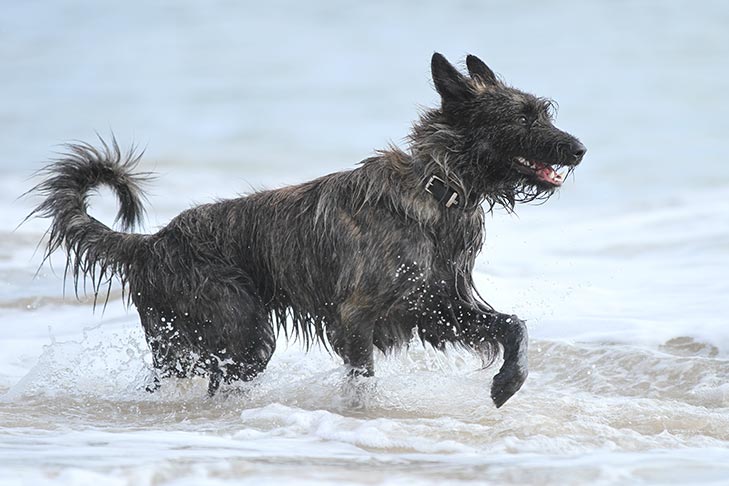You’re likely aware that certain foods, like chocolate or grapes, are toxic to dogs. But can dogs eat salt? As an electrolyte, salt is an essential part of your dog’s health. It helps keep body fluids in balance and plays a role in muscle and nerve function.
But too much salt is dangerous for dogs and can lead to salt toxicosis. How do you know if your dog has had consumed excessive amounts of salt? And are there certain foods you should prevent your dog from eating? Read on to learn more about salt poisoning and how to keep your dog safe.
What is Salt Toxicosis?
Salt toxicosis is also known as hypernatremia. It’s the presence of high levels of sodium (salt) in the bloodstream. The levels of sodium, an electrolyte, are renormally in balance in the body. But when the sodium amount in the blood becomes too high, it draws water out of the cells and into the bloodstream to restore the balance. That harms the cells and can affect the brain and nervous tissue.
Dr. Jerry Klein, DVM, Chief Veterinary Officer for the American Kennel Club, warns that although salt toxicosis is rare, it’s dangerous and potentially deadly. However, excess sodium isn’t something that builds up over time. Rather, it happens over minutes or hours. Dr. Klein explains, “Salt toxicity typically occurs after a single significant dose of salt is ingested over a short period of time.”
How Do Dogs Consume Too Much Salt?
But how does a dog consume a significant dose of salt? According to Dr. Klein, the most common causes of hypernatremia in dogs taken to veterinary hospitals include:
- Drinking large amounts of salt water without access to enough fresh water
- Consuming homemade play dough or salt dough
- Ingesting paintballs
- Eating rock salt (de-icing salt)

Dogs can also suffer from salt poisoning if they get into enema solutions, which contain sodium, or eat excess quantities of table salt or soy sauce. And although feeding your dog salt to induce vomiting was once a suggested practice, it’s no longer recommended, as it can lead to salt toxicosis as well.
Hypernatremia is also tied with access to water. Dogs can tolerate fairly high salt levels if they are able to drink a lot and therefore flush the salt from their system. But if there is no fresh water available or dogs can’t access their fresh water supply, then the pet will be at higher risk.
Should Your Dog Avoid Salty Foods?
The most common way dogs get hypernatremia involves them getting into things they shouldn’t. Puppy-proofing your home to prevent your dog from accessing dangerous substances will go a long way toward protection. And if you take your dog to the ocean, stop them from drinking excess amounts of salt water and instead provide lots of opportunities to drink fresh water.
But what about salty foods like potato chips? Are they safe to feed your dog? Yes, in limited amounts. Dr. Klein explains, “The feeding of salty foods in moderation should not cause salt toxicity. But in small dogs with metabolic issues, it may cause more concern if there is no access to fresh water. Generally, the feeding of excessive salty foods is not good for dogs, especially for those that have certain medical issues such as heart disease because it can cause fluid retention.”
What Are the Symptoms of Salt Poisoning in Dogs?
The size of your dog can affect the danger of salt poisoning, with smaller breeds having a higher risk. Dr. Klein says, “Since most toxicosis is based on the amount of the substance ingested compared to the weight of an animal, it would figure that a smaller dog would need to eat a smaller amount of a toxic substance to become ill than a larger animal.”
According to the American College of Veterinary Pharmacists, salt toxicosis can occur when a dog eats as little as two to three grams of sodium chloride for every kilogram of body weight. That means a toy breed like a Chihuahua could become ill after eating less than a teaspoon, whereas a giant breed like a Great Dane would have to consume over four tablespoons.
Be aware of the following signs your dog may have consumed too much salt:
- Vomiting
- Diarrhea
- Decreased appetite
- Lethargy
- Lack of coordination or being wobbly on their feet
- Excessive thirst or urination
- Tremors or seizures

What to Do If You Suspect Canine Salt Poisoning
If you suspect your dog has consumed too much salt, contact a veterinarian or the Pet Poison Helpline immediately. If caught in time, it’s possible your dog’s body fluids can be brought back in balance. But recovery is not an immediate process. Dr. Klein explains, “The diagnosis of hypernatremia is performed by a veterinarian after assessing clinical signs and history and performing appropriate diagnostics such as bloodwork or urinalysis. The condition may be reversible with intensive care, usually involving hospitalization, intravenous fluids of a specific type, repeat bloodwork, and close constant monitoring over many hours and possibly days.”
Just in case the worst happens, keep emergency numbers programmed into your phone and posted somewhere easy to access. Include your veterinarian’s contact info, the local emergency veterinary clinic, and the Pet Poison Helpline on your list. Then, if you suspect your dog has ingested salt or other poisonous substances, you can access help as soon as possible and give your dog the best chance at recovery.
The post Is Salt Bad for Dogs? appeared first on American Kennel Club.



0 Comments
Recommended Comments
There are no comments to display.